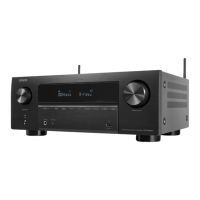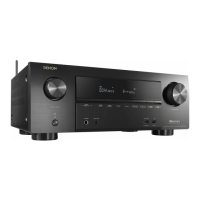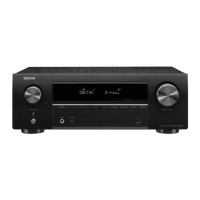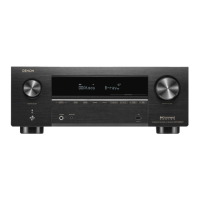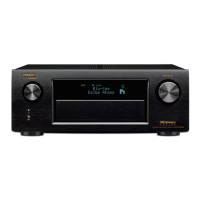Do you have a question about the Denon AVR-X2300W and is the answer not in the manual?
| Receiver type | - |
|---|---|
| Audio output channels | 7.2 channels |
| Power output per channel (20-20KHz@8 Ohm) | 95 W |
| HDMI in | 7 |
| Number of HDMI outputs | 2 |
| Wi-Fi | Yes |
Details on how to install and connect speakers to the unit.
Guidance on connecting a TV, considering HDMI and ARC compatibility.
Instructions for connecting various playback devices like set-top boxes, players.
Steps for connecting the unit to a wired or wireless home network.
Fundamental operations like turning power on, selecting inputs, and adjusting volume.
Instructions for connecting and playing music from an iPod.
How to enjoy music wirelessly from Bluetooth devices.
Instructions for using the built-in tuner to listen to FM and AM broadcasts.
How to play music, image files, or playlists from PC and NAS.
Information and steps for playing Internet Radio stations.
Playing music from iTunes or Apple devices via the network.
Steps to stream Spotify music using the Spotify app.
Overview of all available settings categories and their corresponding page numbers.
Configuration of input connectors and their assignments.
Setup and configuration of connected speakers, including Audyssey calibration.
Settings for connecting and configuring the unit's network capabilities.
Various general settings including language, ECO mode, and display options.
Guides through initial setup, connections, and basic settings.
Enables linking operations with HDMI-connected devices for mutual control.
Transmits TV audio signals via HDMI for playback on the unit.
Selects the HDMI monitor connector for video output.
Sets the output resolution for video signals.
Sets the video signal format (NTSC or PAL) for output to the TV.
Assigns input connectors (HDMI, Digital, Analog, etc.) to input sources.
Automatic speaker and room acoustic calibration for optimal settings.
Manually configuring speaker settings or changing Audyssey settings.
Sets the size of the front speakers (Large or Small).
Sets the distance from the listening position to each speaker.
Sets the volume of test tones to match listening position for each speaker.
Selects how to set the crossover frequency for speakers.
Sets the front speaker A/B selection for sound modes.
Selects a wireless network from a list and enters password.
Sets the IP address within specific ranges for network connection.
Changes the displayed network name of the unit.
Reduces power consumption when the unit is on.
Sets auto standby time for MAIN ZONE when no signals are input.
Adjusts the left and right channel output levels for ZONE2 audio.
Adjusts the display brightness of the unit.
Updates the unit's firmware and sets notification messages.
Shows audio, video, zone, and firmware information.
Protects settings from inadvertent changes by locking them.
Procedure to reset the unit to its factory default settings.
Explains HDMI technologies like Deep Color, 3D, and 4K support.
Lists supported audio formats for playback.
Lists supported video signal resolutions and frame rates.
Explains HDCP copyright protection for digital content.
Illustrates video signal flow to compatible and incompatible TVs.
Lists supported audio and video file formats for USB playback.
Details on file formats, sampling frequency, bit rate, and extensions supported.
Indicates which sound modes and channel outputs are selectable.
Lists available surround parameters for each sound mode.
Table mapping input signals to selectable and default sound modes.
Explains Audyssey and Dolby audio technologies.
Explains Dolby Atmos content delivery and playback.
Explains Dolby Digital technology and its channel configuration.
Describes Dolby Digital Plus as an improved Dolby Digital format.
Explains Dolby Surround as a next-generation surround technology.
Explains Dolby Atmos Enabled speakers and their technology.
Explains Dolby TrueHD as a high-definition lossless audio technology.
Defines DTS and its surround sound capabilities.
Explains DTS-ES Discrete 6.1 format and its surround sound capabilities.
Explains DTS-ES Matrix 6.1 format and its surround sound capabilities.
Describes DTS:X for immersive audio with object-based sound.
Explains DTS Neural:X for immersive audio from older content.
Details specifications for the audio, video, and tuner sections.
Details wireless LAN standards, security, and channel information.
Provides general specifications for Bluetooth system, power, and range.
Specifies the unit's dimensions in inches and millimeters.
States the weight of the unit.
Troubleshooting steps if the unit fails to power on or turns off unexpectedly.
Troubleshooting steps if the remote control is not functioning correctly.
Troubleshooting steps when no audio is output from the speakers.
Addresses issues with volume, HDMI sound, speaker output, and audio formats.
Troubleshooting steps for sound interruptions, noise, and distortion.
Troubleshooting steps when no video signal is displayed on the TV.
Troubleshooting steps when the menu or status screen is not visible on the TV.
Troubleshooting steps for connecting and playing back iPods.
Troubleshooting steps when USB memory devices cannot be recognized or played.
Troubleshooting steps for Bluetooth connection and playback issues.
Troubleshooting steps for Internet radio playback problems.
Solves problems with playing music files from PC or NAS.
Troubleshooting steps when HDMI control features are not functioning.
Solves issues with connecting to a wireless LAN network.



